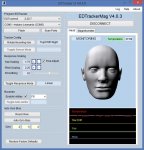GUI not Conneting Properly to Tracker
I am having trouble with a new EDTracker. I had built one with a 6050 chip and it worked a treat. When the micro USB was broken of the Arduino I decided to build a new one with a 9150 and I cannot get it to connect to the GUI (4.0.4) The GUI recognizes the Arduino (but does not call it an EDTracker), and it says that it is flashing the EDTracker2_9150 4.0.3 frimware on to the device, but but after the flashing, it is not connecting. At the top right where it says "EDTrackerMag V4.0.0" in the manual it says "Not Connected". The magnetometer tab does not appear over the head. Clicking "Connect to Tracker" does nothing other than change the box below that to "connected" no movement and no ability to calibrate. I have uninstalled and reinstalled the Arduino drivers, and tried all the different USB ports on the computer. I have redownloaded the GUI and tried the earlier versions. I am at the end of my debugging abilities. Do I have a bad chip? Did I screw up the building? Is there something else to download or update. Any help you can provide would be appreciated, I am really new to building this sort of stuff.
Windows 7 64bit SP-1
i5-4670k 3.4 GHz
8 GB ram
NVIDA GTX 760
EDIT: Windows sees it as "Arduino Leonardo" even after calibration. (Sorry to reply via Edit, but apparently the anti-spam software is not sure whether I am a bot or not...)
Edit 2 Several Hours Later.: I tried using the sparkfun drivers for the pro-mico and windows will recognize it now as a "Sparfun Pro-Micro", but flashing with the GUI will not cause it to be recognized as an EDTracker. I tried flashing the 2.5.3 sketch and the GUI will give temp reading, and recognize the flash, but no motion.
I am having trouble with a new EDTracker. I had built one with a 6050 chip and it worked a treat. When the micro USB was broken of the Arduino I decided to build a new one with a 9150 and I cannot get it to connect to the GUI (4.0.4) The GUI recognizes the Arduino (but does not call it an EDTracker), and it says that it is flashing the EDTracker2_9150 4.0.3 frimware on to the device, but but after the flashing, it is not connecting. At the top right where it says "EDTrackerMag V4.0.0" in the manual it says "Not Connected". The magnetometer tab does not appear over the head. Clicking "Connect to Tracker" does nothing other than change the box below that to "connected" no movement and no ability to calibrate. I have uninstalled and reinstalled the Arduino drivers, and tried all the different USB ports on the computer. I have redownloaded the GUI and tried the earlier versions. I am at the end of my debugging abilities. Do I have a bad chip? Did I screw up the building? Is there something else to download or update. Any help you can provide would be appreciated, I am really new to building this sort of stuff.
Windows 7 64bit SP-1
i5-4670k 3.4 GHz
8 GB ram
NVIDA GTX 760
EDIT: Windows sees it as "Arduino Leonardo" even after calibration. (Sorry to reply via Edit, but apparently the anti-spam software is not sure whether I am a bot or not...)
Edit 2 Several Hours Later.: I tried using the sparkfun drivers for the pro-mico and windows will recognize it now as a "Sparfun Pro-Micro", but flashing with the GUI will not cause it to be recognized as an EDTracker. I tried flashing the 2.5.3 sketch and the GUI will give temp reading, and recognize the flash, but no motion.
Last edited:

